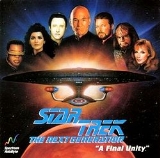
Star Trek: The Next Generation - A Final Unity
Encyclopedia
Star Trek: The Next Generation – A Final Unity is a computer game by Spectrum HoloByte
, based on the Star Trek
universe.
The cast of Star Trek: The Next Generation
reprise their roles, providing the voices of their respective characters.
intercepts a distress signal from the crew of a Garidian scout ship, seeking asylum in Federation
space. After a brief confrontation with the commander of a Garidian Warbird (similar in design to a Romulan D'deridex Warbird except white in color with a red starburst design on the nose), the crew of the scout ship is beamed aboard the Enterprise. One of the refugees mentions to Captain Picard that they are in search of the Lawgiver's legendary Fifth Scroll, which could aid in preventing war on Garid. Picard agrees to assist them, and the crew of the Enterprise sets out in search of clues to the location of the scroll.
After searching various star system
s and completing several away missions, the crew of the Enterprise realizes that the scroll points to the existence of an enormous and powerful ancient structure, known as the Unity Device, that was created by the Chodak, an unknown alien race, during the peak of their civilization.
The storyline takes place around stardate
47111.1, according to the opening sequence of the game. This places the events between the first two episodes of the seventh season of the series, Descent and Liaisons. Because the non-canonical Chodak race reappear in the Star Trek: Generations game, it is considered a sort of sequel to A Final Unity.
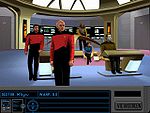 Gameplay is mostly linear in nature, sometimes branching partially depending on choices made during various conversations.
Gameplay is mostly linear in nature, sometimes branching partially depending on choices made during various conversations.
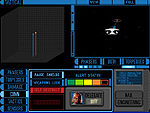 Onboard the Enterprise, gameplay basically amounts to waiting until the ship arrives at its next destination, and occasionally conversing with various crewmembers for advice. There are various areas of the main bridge that can be interacted with to control the ship and consult with various people.
Onboard the Enterprise, gameplay basically amounts to waiting until the ship arrives at its next destination, and occasionally conversing with various crewmembers for advice. There are various areas of the main bridge that can be interacted with to control the ship and consult with various people.
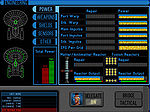
The turbolift allows for access to other areas of the ship.
 The majority of the gameplay takes place by controlling an away team on various space stations and alien worlds, which is the pure adventure game
The majority of the gameplay takes place by controlling an away team on various space stations and alien worlds, which is the pure adventure game
part of the game. The away team is selected by the player and is then controlled in a point-and-click
manner by selecting the desired command from the interface in the lower area of the screen. Items in the inventory can be used to interact with the environment in much the same way.
As in all adventure games, inventory items are used to solve various puzzles (and in this game, often to allow interface with alien technology). Interaction with the environment, however, is fairly limited, and attempting to perform an action that is outside the game's boundaries results in the currently selected character to comment that they don't believe it would work. There is some variety however, to the comments and responses of the characters, depending on the combination the player chose, giving some realistic richness to the experience.
Upon completion of the away mission, the team is beamed up, and Enterprise awaits further orders or acts with the new information provided by the away mission.
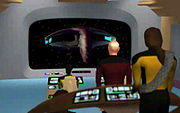 A Final Unity is one of the games under the now "classic" era of Star Trek Gaming. Originally the game was penned for a release shortly after Interplay's Star Trek: 25th Anniversary. Since 25th Anniversary was released at the end of 1992, A Final Unity was scheduled to be released in 1993, but did not make the projected release date.
A Final Unity is one of the games under the now "classic" era of Star Trek Gaming. Originally the game was penned for a release shortly after Interplay's Star Trek: 25th Anniversary. Since 25th Anniversary was released at the end of 1992, A Final Unity was scheduled to be released in 1993, but did not make the projected release date.
A Final Unity was a benchmark game for its time, considering the hardware and programming limitations of mid-1990s computer game development. The cutscenes, along with the recreations of the characters, were critically hailed as some of the best renderings and motion video for a game of that year. In addition, the entire starring cast of the show and Majel Barrett, the voice of the computer, were hired to reprise their roles in voice-over
s for the game. Although A Final Unity didn't commercially perform as well as Interplay's prior games from 1994, it did mark Spectrum HoloByte's entry into the gaming mind of the then small Star Trek gaming community. Spectrum Holobyte acquired Microprose
shortly thereafter, and continued developing Star Trek games under the Microprose name.
To deliver its technologically advanced gaming experience, A Final Unity officially requires a floating point
coprocessor
(FPU
), perhaps due to the space combat portion of the game which uses texture-mapped
real-time 3D graphics
. DOS games usually made an FPU optional because the games either didn't use a significant amount of floating point arithmetic or just added some extra bonus features if the computer was equipped with one. A CPU without an FPU can perform floating-point arithmetic, but at a considerably slower rate because the instructions are emulated. As such, the game can be played without an FPU, but with reduced performance.
Spectrum HoloByte
Spectrum HoloByte, Inc. was a video game developer and publisher originally based in Alameda, California.The company was founded in 1983 and was most famous for its simulation games, notably the Falcon series of flight simulators and Vette!, a driving simulator from 1989...
, based on the Star Trek
Star Trek
Star Trek is an American science fiction entertainment franchise created by Gene Roddenberry. The core of Star Trek is its six television series: The Original Series, The Animated Series, The Next Generation, Deep Space Nine, Voyager, and Enterprise...
universe.
The cast of Star Trek: The Next Generation
Star Trek: The Next Generation
Star Trek: The Next Generation is an American science fiction television series created by Gene Roddenberry as part of the Star Trek franchise. Roddenberry, Rick Berman, and Michael Piller served as executive producers at different times throughout the production...
reprise their roles, providing the voices of their respective characters.
Plot
While on routine patrol of the Romulan neutral zone, the EnterpriseUSS Enterprise (NCC-1701-D)
The USS Enterprise is a 24th century starship in the Star Trek fictional universe and the principal setting of the Star Trek: The Next Generation television series...
intercepts a distress signal from the crew of a Garidian scout ship, seeking asylum in Federation
United Federation of Planets
The United Federation of Planets, also known as "The Federation" is a fictional interplanetary federal republic depicted in the Star Trek television series and motion pictures...
space. After a brief confrontation with the commander of a Garidian Warbird (similar in design to a Romulan D'deridex Warbird except white in color with a red starburst design on the nose), the crew of the scout ship is beamed aboard the Enterprise. One of the refugees mentions to Captain Picard that they are in search of the Lawgiver's legendary Fifth Scroll, which could aid in preventing war on Garid. Picard agrees to assist them, and the crew of the Enterprise sets out in search of clues to the location of the scroll.
After searching various star system
Star system
A star system or stellar system is a small number of stars which orbit each other, bound by gravitational attraction. A large number of stars bound by gravitation is generally called a star cluster or galaxy, although, broadly speaking, they are also star systems.-Binary star systems:A stellar...
s and completing several away missions, the crew of the Enterprise realizes that the scroll points to the existence of an enormous and powerful ancient structure, known as the Unity Device, that was created by the Chodak, an unknown alien race, during the peak of their civilization.
The storyline takes place around stardate
Stardate
A stardate is a date in the fictional system of time measurement developed for Star Trek, commonly heard at the beginning of a voiceover log entry such as "Captain's log, stardate 41153.7...
47111.1, according to the opening sequence of the game. This places the events between the first two episodes of the seventh season of the series, Descent and Liaisons. Because the non-canonical Chodak race reappear in the Star Trek: Generations game, it is considered a sort of sequel to A Final Unity.
Gameplay

Enterprise

- The conference lounge allows the player to ask advice from the Garidian refugees.
- The Conn can be used to change the ship's destination and speed, though when a mission begins destination and speed are set automatically. The player though, has the liberty to meddle around visiting bases, sectors and systems at will, off-story, but this will not affect anything and there is nothing to do to off-scenario places.

- Various information on planets, alien species, and previous missions can be accessed from the Ops console, manned by Lt. Cmdr. DataData (Star Trek)Lieutenant Commander Data is a character in the fictional Star Trek universe portrayed by actor Brent Spiner. He appears in the television series Star Trek: The Next Generation and the feature films Star Trek Generations, Star Trek: First Contact, Star Trek: Insurrection, and Star Trek...
. - The tactical console is manned by Lt. WorfWorfWorf, played by Michael Dorn, is a main character in Star Trek: The Next Generation and in seasons four to seven of Star Trek: Deep Space Nine. He also appears in the films based on The Next Generation. Worf is the first Klingon main character to appear in Star Trek, and has appeared in more Star...
. Accessing it automatically brings the ship to red alertRed Alert (Star Trek)Red alert is a Starfleet alert state in the Star Trek fictional universe. It is the highest state of alert for a Starfleet vessel or installation, indicating an extremely dangerous situation such as entering combat....
status. During the occasional battle with an enemy ship, control of the tactical console can be delegated to Lt. Worf, or controlled by the player.
The turbolift allows for access to other areas of the ship.
- From engineering, power levels can be adjusted and resources applied toward damaged systems can be designated. Control of engineering can be delegated to Lt. Cmdr. Geordi La ForgeGeordi La ForgeLieutenant Commander Geordi La Forge is a regular character in the television series Star Trek: The Next Generation and its feature films, played by LeVar Burton...
. Players could manipulate engineering to such a degree it was possible to cause a warp core breach or eject the warp core. - In the transporterTransporter (Star Trek)A transporter is a fictional teleportation machine used in the Star Trek universe. Transporters convert a person or object into an energy pattern , then "beam" it to a target, where it is reconverted into matter...
room, an away team can be assembled and an inventory chosen, though each mission has an automatically assigned away team (except on "Captain" difficulty, where you can choose your own team and equipment). - On the holodeck, any previous cut scenes can be viewed, as well as a brief tutorial going over the various controls of the ship.
Away Missions

Adventure game
An adventure game is a video game in which the player assumes the role of protagonist in an interactive story driven by exploration and puzzle-solving instead of physical challenge. The genre's focus on story allows it to draw heavily from other narrative-based media such as literature and film,...
part of the game. The away team is selected by the player and is then controlled in a point-and-click
Point-and-click
Point-and-click is the action of a computer user moving a cursor to a certain location on a screen and then pressing a mouse button, usually the left button , or other pointing device...
manner by selecting the desired command from the interface in the lower area of the screen. Items in the inventory can be used to interact with the environment in much the same way.
As in all adventure games, inventory items are used to solve various puzzles (and in this game, often to allow interface with alien technology). Interaction with the environment, however, is fairly limited, and attempting to perform an action that is outside the game's boundaries results in the currently selected character to comment that they don't believe it would work. There is some variety however, to the comments and responses of the characters, depending on the combination the player chose, giving some realistic richness to the experience.
Upon completion of the away mission, the team is beamed up, and Enterprise awaits further orders or acts with the new information provided by the away mission.
Background

A Final Unity was a benchmark game for its time, considering the hardware and programming limitations of mid-1990s computer game development. The cutscenes, along with the recreations of the characters, were critically hailed as some of the best renderings and motion video for a game of that year. In addition, the entire starring cast of the show and Majel Barrett, the voice of the computer, were hired to reprise their roles in voice-over
Voice-over
Voice-over is a production technique where a voice which is not part of the narrative is used in a radio, television production, filmmaking, theatre, or other presentations...
s for the game. Although A Final Unity didn't commercially perform as well as Interplay's prior games from 1994, it did mark Spectrum HoloByte's entry into the gaming mind of the then small Star Trek gaming community. Spectrum Holobyte acquired Microprose
MicroProse
MicroProse was a video game publisher and developer, founded by Wild Bill Stealey and Sid Meier in 1982 as Microprose Software. In 1993, the company became a subsidiary of Spectrum HoloByte and has remained a subsidiary or brand name under several other corporations since...
shortly thereafter, and continued developing Star Trek games under the Microprose name.
To deliver its technologically advanced gaming experience, A Final Unity officially requires a floating point
Floating point
In computing, floating point describes a method of representing real numbers in a way that can support a wide range of values. Numbers are, in general, represented approximately to a fixed number of significant digits and scaled using an exponent. The base for the scaling is normally 2, 10 or 16...
coprocessor
Coprocessor
A coprocessor is a computer processor used to supplement the functions of the primary processor . Operations performed by the coprocessor may be floating point arithmetic, graphics, signal processing, string processing, or encryption. By offloading processor-intensive tasks from the main processor,...
(FPU
Floating point unit
A floating-point unit is a part of a computer system specially designed to carry out operations on floating point numbers. Typical operations are addition, subtraction, multiplication, division, and square root...
), perhaps due to the space combat portion of the game which uses texture-mapped
Texture mapping
Texture mapping is a method for adding detail, surface texture , or color to a computer-generated graphic or 3D model. Its application to 3D graphics was pioneered by Dr Edwin Catmull in his Ph.D. thesis of 1974.-Texture mapping:...
real-time 3D graphics
3D computer graphics
3D computer graphics are graphics that use a three-dimensional representation of geometric data that is stored in the computer for the purposes of performing calculations and rendering 2D images...
. DOS games usually made an FPU optional because the games either didn't use a significant amount of floating point arithmetic or just added some extra bonus features if the computer was equipped with one. A CPU without an FPU can perform floating-point arithmetic, but at a considerably slower rate because the instructions are emulated. As such, the game can be played without an FPU, but with reduced performance.
External links
- Star Trek Gamer's review of A Final Unity
- Star Trek: The Next Generation - A Final Unity in Memory AlphaMemory AlphaMemory Alpha is a wiki that is an encyclopedic reference for topics related to the Star Trek fictional universe. Conceived by Harry Doddema and Dan Carlson in September 2003 and officially launched on December 5 of that year, it uses the wiki model and is hosted by Wikia, Inc. on the MediaWiki...
, with intensive details and descriptions of plot and characters

